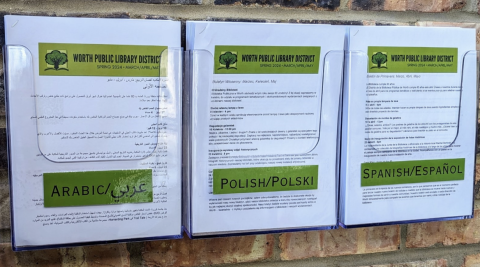My Library Is... Removing Barriers by Translating Collateral into Community Languages
- Log in to post comments

For the last several years, our library has worked to make our space welcoming, accessible, and inclusive. One of the areas we wanted to improve on was by reaching our whole community, which is diverse in languages spoken. We saw a lot of kids translating our collateral for their parents and grandparents, and we wanted to make it easier for these families, and all our patrons, to know what we offer. For our project, we chose to translate our quarterly newsletter, library card application, and welcome brochure so that when they walked into the library, they felt welcome and seen. We chose the top three languages spoken in the school district to focus on: Arabic, Polish, and Spanish. For the translations, I hired teachers who either were native speakers or taught the language to ensure their accuracy and usability.
We also started offering story times in the same community languages with the goal of offering one in each language in each quarter. These didn’t catch on as quickly as I had expected them too, but by the end of the grant cycle, our Polish story time was finding its feet and we had patrons requesting more sessions of it. The presenter I hired for our Arabic story time unfortunately was sometimes unavailable, so that one hasn’t grown as much as I hoped. Two of our staff members hosted the Spanish story time which has had consistent attendance.
We have been buying more picture books, vox books, and graphic novels in the community languages to have available, especially for families coming in for story time. We are hoping to grow the adult collection as well in our community languages so that parents aren’t left out when book browsing at the library. It has been challenging to find quality books in other languages, but our Youth Services Department has done their best.
If I were to do this project again, or implement it at another library, I would:
- Have a backup presenter for each language in case one didn’t work out, I was a bit stuck without someone to replace them.
- Tie the story times into bigger holidays, so they were a bigger production instead of regular story time.
All in all, I am pleased with the success of this project. It was an important first step in showing our community that we want everyone to feel welcome when using their library. Our community is proof that many households are multilingual, and it is our responsibility to pivot to meet those patrons where they are. I am planning on folding these offerings into our budget so that these offerings can continue in the future.
This week’s blog post was written by Rachel Snyder, Library Director, Worth Public Library District.
This project was made possible by the My Library Is... Grant.
